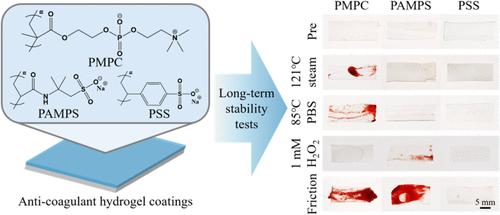长效心血管装置抗凝水凝胶涂层的稳定性研究
IF 3.9
2区 化学
Q2 CHEMISTRY, MULTIDISCIPLINARY
引用次数: 0
摘要
植入式心血管装置已经彻底改变了心血管疾病的治疗,但它们的长期功能而不引起血栓形成是一个持续的挑战。虽然抗凝涂层的表面改性大大提高了器件的生物相容性,但其在复杂生理环境中的长期稳定性仍存在疑问。本文研究了聚(2-甲基丙烯酰氧乙基磷酸胆碱)(PMPC)、聚(2-丙烯酰-2-甲基丙磺酸钠)(PAMPS)和聚(4-苯乙烯磺酸钠)(PSS)三种抗凝水凝胶涂层的稳定性。通过x射线光电子能谱(XPS)和衰减全反射傅里叶变换红外(ATR-FTIR)光谱验证了这些涂层在器件表面的制备。体外抗凝试验证实该涂层具有明显的抗凝作用。在所有三种涂层中,PSS涂层在综合测试中表现出优异的化学和机械稳定性,显示出改善植入式心血管装置长期抗凝性能的巨大潜力。本文章由计算机程序翻译,如有差异,请以英文原文为准。

Stability Study of Anticoagulant Hydrogel Coatings Toward Long-Term Cardiovascular Devices
Implantable cardiovascular devices have revolutionized the treatment of cardiovascular diseases, yet their long-term functionality without causing thrombosis is a persistent challenge. Although the surface modification of anticoagulant coating has greatly improved the biocompatibility of the devices, its long-term stability in complex physiological environments still remains questionable. Herein, the stability of three anticoagulant hydrogel coatings, poly(2-methacryloyloxyethyl phosphorylcholine) (PMPC), poly(sodium 2-acryloyl-2-methylpropanesulfonate) (PAMPS), and poly(4-styrenesulfonate sodium) (PSS), is studied. The fabrication of these coatings onto device surfaces is validated by using X-ray photoelectron spectroscopy (XPS) and attenuated total reflectance Fourier transform infrared (ATR-FTIR) spectroscopy. In vitro anticoagulation assays confirm the coatings’ significant anticoagulant effects. Among all three coatings, the PSS coating demonstrated superior chemical and mechanical stability in the comprehensive tests, showing great potential for improving the long-term anticoagulant performance of implantable cardiovascular devices.
求助全文
通过发布文献求助,成功后即可免费获取论文全文。
去求助
来源期刊

Langmuir
化学-材料科学:综合
CiteScore
6.50
自引率
10.30%
发文量
1464
审稿时长
2.1 months
期刊介绍:
Langmuir is an interdisciplinary journal publishing articles in the following subject categories:
Colloids: surfactants and self-assembly, dispersions, emulsions, foams
Interfaces: adsorption, reactions, films, forces
Biological Interfaces: biocolloids, biomolecular and biomimetic materials
Materials: nano- and mesostructured materials, polymers, gels, liquid crystals
Electrochemistry: interfacial charge transfer, charge transport, electrocatalysis, electrokinetic phenomena, bioelectrochemistry
Devices and Applications: sensors, fluidics, patterning, catalysis, photonic crystals
However, when high-impact, original work is submitted that does not fit within the above categories, decisions to accept or decline such papers will be based on one criteria: What Would Irving Do?
Langmuir ranks #2 in citations out of 136 journals in the category of Physical Chemistry with 113,157 total citations. The journal received an Impact Factor of 4.384*.
This journal is also indexed in the categories of Materials Science (ranked #1) and Multidisciplinary Chemistry (ranked #5).
 求助内容:
求助内容: 应助结果提醒方式:
应助结果提醒方式:


